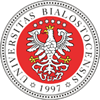Proszę używać tego identyfikatora do cytowań lub wstaw link do tej pozycji:
http://hdl.handle.net/11320/11612Pełny rekord metadanych
| Pole DC | Wartość | Język |
|---|---|---|
| dc.contributor.author | Kovačević, Dominika | - |
| dc.date.accessioned | 2021-09-28T11:32:13Z | - |
| dc.date.available | 2021-09-28T11:32:13Z | - |
| dc.date.issued | 2021 | - |
| dc.identifier.citation | Elpis, T. 23, 2021, s. 105-111 | pl |
| dc.identifier.issn | 1508-7719 | - |
| dc.identifier.uri | http://hdl.handle.net/11320/11612 | - |
| dc.description.abstract | The word “Allah” is associated usually with Islam. However, this term had been used among Arab Christians much earlier before the rise of Islam. Arabic language has been used in Orthodox service for almost 2000 years, so many terms have been developed long time ago. Among the most basic terms are the ones that call God and describe Him. They are used in the hymnography and prayers, sermons, articles and everyday life. However, in Polish literature those terms are still little known. Since Arabic belongs to the Semitic family of languages, its character is very different from Greek, Church Slavonic and Polish, and this affects a different point of view on some theological terms and also their variety. It also results in wealth of the terms related to God. The main reason of the differences in comparison with European languages is specific system of the Arabic language: the system of roots and themes. This is specified in the introductory part. The most basic terms related to God are presented and analyzed below. The terms are taken mainly from the liturgical texts, and some of them also from the Holy Scripture and sermons. Each term is also written in Church Slavonic to make it easier for the reader to understand it, since the Polish Orthodox terminology has not yet been established and unified. Each Arabic term is written in the original notation and ISO transcription used by Arabists in Poland. | pl |
| dc.description.abstract | Słowo „Allah” zazwyczaj utożsamiane jest z islamem. Jednakże ten termin był używany przez arabskich chrześcijan na długo przed powstaniem islamu. Język arabski jest używany na prawosławnych nabożeństwach od blisko 2000 tysięcy lat. Przeto wiele terminów rozwinęło się dawno temu. Wśród najbardziej podstawowych terminów są te nazywające Boga i opisujące Go. Stosowane są one w hymnografii i modlitwach, kazaniach, artykułach i życiu codziennym. Jednakże, w polskie literaturze te terminy wciąż są mało znane. Jako że arabski należy do rodziny języków semickich, to jego charakter bardzo różni się od greckiego, cerkiewnosłowiańskiego czy polskiego. To zaś wpływa na inną perspektywę na poszczególne terminy teologiczne oraz ich różnorodność. To także skutkuje bogactwem terminów odnoszących się do Boga. Głównym powodem tych różnic w porównaniu z językami europejskimi jest specyficzny system języka arabskiego: system rdzeni i tematów. To jest wyjaśnione w części wstępnej. Następne są przedstawione i przeanalizowane najbardziej podstawowe terminy związane z Bogiem. Są one wzięte przede wszystkim z tekstów liturgicznych, a niektóre także z Pisma Świętego i kazań. Każdy termin jest napisany również w języku cerkiewnosłowiańskim, aby czytelnikowi łatwiej było go zrozumieć, jako że polska prawosławna terminologia wciąż nie jest dobrze ugruntowana i jednolita. Każdy termin arabski jest w oryginalnym zapisie oraz transkrypcji ISO używanej przez arabistów w Polsce. | pl |
| dc.language.iso | pl | pl |
| dc.publisher | Wydawnictwo Uniwersytetu w Białymstoku | pl |
| dc.rights | Attribution-ShareAlike 4.0 International | |
| dc.rights.uri | https://creativecommons.org/licenses/by-sa/4.0/ | |
| dc.subject | Arabic | pl |
| dc.subject | Orthodox | pl |
| dc.subject | terminology | pl |
| dc.subject | God | pl |
| dc.subject | arabski | pl |
| dc.subject | prawosławie | pl |
| dc.subject | terminologia | pl |
| dc.subject | Bóg | pl |
| dc.title | Allah i nie tylko – podstawowe określenia Boga w arabskiej terminologii prawosławnej | pl |
| dc.title.alternative | Allah and more - basic terms related to God in the Arab Orthodox terminology | pl |
| dc.type | Article | pl |
| dc.rights.holder | Attribution-ShareAlike 4.0 International (CC BY-SA 4.0) | pl |
| dc.identifier.doi | 10.15290/elpis.2021.23.12 | - |
| dc.description.Email | domkov@wp.pl | pl |
| dc.description.Affiliation | Chrześcijańska Akademia Teologiczna, Wydział Teologiczny, Polska | pl |
| dc.description.references | Al-Kitāb al-Muqaddas ayy kutub al-ʿAhd al-Qadīm wa-ăl-ʿAhd al-Ǧadīd. At-Tarǧama al-ʿarabiyya al-muštarika min al-luḡāt al-aṣliyya maʿ al-kutub al-yūnāniyya min At-Tarǧama as-Sabʿīniyya (1995). Lubnān: Dār al-Kitāb al-Muqaddas fī ăš-Šarq al-Awṣaṭ. | pl |
| dc.description.references | At-Taʿziya al-Ḥaqīqiyya fī ăṣ-Ṣalawāt al-Ilahiyya (1940). New York: The Blackshaw Press, Inc. [New York: The Blackshaw Press, Inc. | pl |
| dc.description.references | Kitāb al-Afẖūlūgī al-Kabīr. (1955). Beirut: The Syrian Antiochian Orthodox Archdiocese of New York and All North America. | pl |
| dc.description.references | Kitāb al-Afẖūlūgī aṣ-Ṣaḡīr. (1989). Ṭarāblus: Dār al-Kalima wa-maktabat as-Sā’iḥ. | pl |
| dc.description.references | H̱ uḍr, Ǧ. (2003). Aǧdād Al-Masīḥ. An-Nahār. | pl |
| dc.description.references | H̱ uḍr, Ǧ. (2007). Aḏ-̣ Ḏụ hūr al-Ilahī. Raʿiyyatī (21). | pl |
| dc.description.references | Graf, G. (1954). Verzeichnis arabischer kirchlicher Termini. Louvain: Imprimerie orientaliste, L. Durbecq. | pl |
| dc.description.volume | 23 | pl |
| dc.description.firstpage | 105 | pl |
| dc.description.lastpage | 111 | pl |
| dc.identifier.citation2 | Elpis | pl |
| dc.identifier.orcid | 0000-0002-8094-9472 | - |
| Występuje w kolekcji(ach): | Elpis, 2021, T. 23 | |
Pliki w tej pozycji:
| Plik | Opis | Rozmiar | Format | |
|---|---|---|---|---|
| Elpis_23_2021_D_Kovacevic_Allah_i_nie_tylko.pdf | 380,36 kB | Adobe PDF | Otwórz |
Pozycja ta dostępna jest na podstawie licencji Licencja Creative Commons CCL


